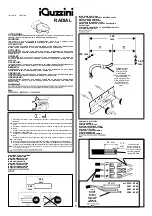
Technical Tips:
Range appears limited
1. Check that the sensor is level from
side to side and pointed at the area
you desire. If unit is tilted, part of the
Detection Zone may be high in the
air over peoples heads.
Solution: Position sensor exactly
level from side to side.
2. Check that the sensor is not
mounted too high. If mounted above
20 feet, much of the usable range
will be lost.
Solution: Mounting at 4’ to 8’ allows
maximum range.
3. If sensor is painted, make sure
there is no paint on the lens and that
the lens paint mask is removed.
4. Check that movement is not direct-
ly towards sensor. Sensor will see
movement across its pattern more
quickly. To fix, move the sensor.
5. Check that movement far away
and directly towards sensor is not
entirely within one Detection Pattern
finger.
Problem: Sensor will not detect until
movement crosses from one finger
into a second finger.
Solution: “Micro Adjust” sensor by tilt-
ing mounting plate 1/16”. This small
adjustment may move the zones to
allow earlier detection.
11
Lights Turn Off
Too Quickly
1. Check if sensor is being “tricked”
by reflected light. If lights shine or
reflect into the photocell, (located
behind the lens), the unit will go on
briefly and turn off thinking it is
daytime.
Problems:
Lights reflect into photocell or lights
shine directly into photocell.
Because the SmartLantern can fit a
wide variety of lanterns, it is possible
some lantern’s shiny metal or glass
surfaces will allow reflections to be
seen by the sensor.
Solution: Adjust Photocell Control
slightly clockwise, toward the sun
symbol. This allows the sensor to
function in brighter ambient light
conditions. Alternatively, move the
lights or mask the lens in the direc-
tion of the lights or reflections. If the
problem persists, it may be necessary
to increase the length of the sun shield
over the sensor using weatherproof
tape or some other material.
Technical Tips:
Lights Do Not Turn On
1. Check that lightbulbs and fixtures
work. Compare wiring to the Wiring
Diagram in this manual. Check that
the power is on.
2. If installing during daylight, remem-
ber that the sensor will provide a 3
minute Test Period after power is
turned on. After 3 minutes, the sensor
will switch to Automatic Mode and will
not work during daylight if the
Photocell Control is turned to or near
the night only position (fully counter
clockwise to the moon symbol).
If you require another 3 minute Test
Period, turn the power off for at least
10 seconds and back on again.
If you require the sensor to operate
both in low level light and at night,
turn the Photocell Control knob fully
clockwise to the sun symbol.
3. Check that lights from other
sources, such as adjacent porch
lights, garden lights, streetlights or
lights from inside the house are not in
the sensor’s view. See #1 under
“Lights Turn Off Too Quickly”.
4. Was sensor wired hot? If so,
circuitry may have been damaged.
5. If sensor is painted, make sure
there is no paint on the lens and that
the lens paint mask is removed.
12


























